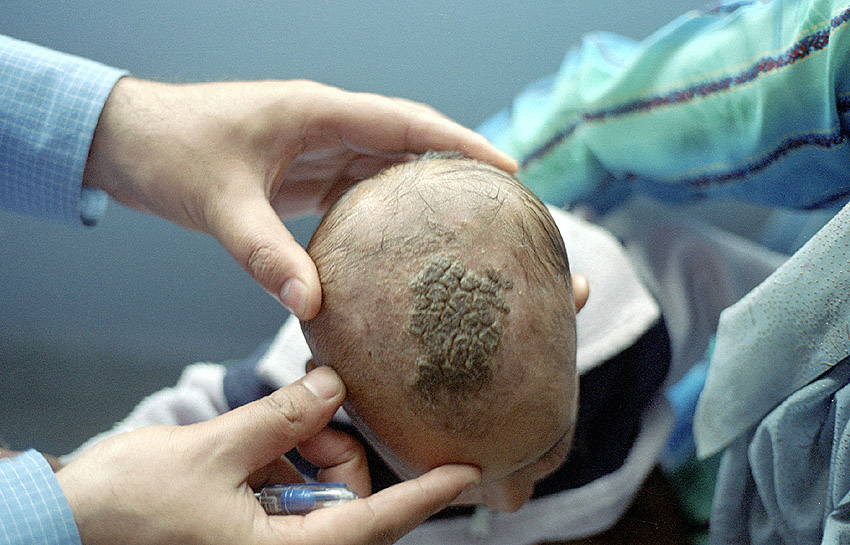Favus

Editor-In-Chief: Prab R Tumpati, MD
Obesity, Sleep & Internal medicine
Founder, WikiMD Wellnesspedia &
W8MD medical weight loss NYC and sleep center NYC
| Favus | |
|---|---|

| |
| Synonyms | Tinea favosa |
| Pronounce | N/A |
| Specialty | N/A |
| Symptoms | Scaly, crusted lesions on the scalp, hair loss |
| Complications | Scarring alopecia, secondary bacterial infections |
| Onset | Usually in childhood |
| Duration | Chronic if untreated |
| Types | N/A |
| Causes | Fungal infection by Trichophyton schoenleinii |
| Risks | Poor hygiene, crowded living conditions |
| Diagnosis | Clinical examination, Wood's lamp examination, KOH test |
| Differential diagnosis | Seborrheic dermatitis, Psoriasis, Alopecia areata |
| Prevention | Good hygiene, avoiding sharing personal items |
| Treatment | Antifungal medications such as Griseofulvin, Terbinafine |
| Medication | N/A |
| Prognosis | Good with treatment, but may result in permanent hair loss |
| Frequency | Rare in developed countries, more common in rural areas of developing countries |
| Deaths | N/A |

Favus is a chronic infection that affects the scalp, characterized by the formation of yellow, cup-shaped crusts. It is caused by a fungus called Trichophyton schoenleinii. Favus is rare and is most commonly seen in rural areas of developing countries.
Causes[edit]
Favus is caused by a fungus called Trichophyton schoenleinii. This fungus is spread through direct contact with an infected person or animal, or indirectly through contact with objects such as combs, hats, and bedding that have been contaminated with the fungus.
Symptoms[edit]
The main symptom of favus is the formation of yellow, cup-shaped crusts on the scalp. These crusts, known as scutula, are often surrounded by a ring of red, inflamed skin. Other symptoms may include itching, hair loss, and a foul smell.
Diagnosis[edit]
Favus is diagnosed through a physical examination and laboratory tests. The doctor may take a sample of the crusts or affected hair for microscopic examination and culture. The fungus Trichophyton schoenleinii can be identified under the microscope or in culture.
Treatment[edit]
Treatment for favus involves the use of antifungal medications. These may be applied topically to the affected area or taken orally. In severe cases, it may be necessary to remove the affected hair.
Prevention[edit]
Prevention of favus involves good personal hygiene and avoiding contact with infected individuals or animals. It is also important to avoid sharing personal items such as combs, hats, and bedding.
See also[edit]
Ad. Transform your life with W8MD's Budget GLP-1 injections from $75


W8MD offers a medical weight loss program to lose weight in Philadelphia. Our physician-supervised medical weight loss provides:
- Weight loss injections in NYC (generic and brand names):
- Zepbound / Mounjaro, Wegovy / Ozempic, Saxenda
- Most insurances accepted or discounted self-pay rates. We will obtain insurance prior authorizations if needed.
- Generic GLP1 weight loss injections from $75 for the starting dose.
- Also offer prescription weight loss medications including Phentermine, Qsymia, Diethylpropion, Contrave etc.
NYC weight loss doctor appointmentsNYC weight loss doctor appointments
Start your NYC weight loss journey today at our NYC medical weight loss and Philadelphia medical weight loss clinics.
- Call 718-946-5500 to lose weight in NYC or for medical weight loss in Philadelphia 215-676-2334.
- Tags:NYC medical weight loss, Philadelphia lose weight Zepbound NYC, Budget GLP1 weight loss injections, Wegovy Philadelphia, Wegovy NYC, Philadelphia medical weight loss, Brookly weight loss and Wegovy NYC
|
WikiMD's Wellness Encyclopedia |
| Let Food Be Thy Medicine Medicine Thy Food - Hippocrates |
Medical Disclaimer: WikiMD is not a substitute for professional medical advice. The information on WikiMD is provided as an information resource only, may be incorrect, outdated or misleading, and is not to be used or relied on for any diagnostic or treatment purposes. Please consult your health care provider before making any healthcare decisions or for guidance about a specific medical condition. WikiMD expressly disclaims responsibility, and shall have no liability, for any damages, loss, injury, or liability whatsoever suffered as a result of your reliance on the information contained in this site. By visiting this site you agree to the foregoing terms and conditions, which may from time to time be changed or supplemented by WikiMD. If you do not agree to the foregoing terms and conditions, you should not enter or use this site. See full disclaimer.
Credits:Most images are courtesy of Wikimedia commons, and templates, categories Wikipedia, licensed under CC BY SA or similar.
Translate this page: - East Asian
中文,
日本,
한국어,
South Asian
हिन्दी,
தமிழ்,
తెలుగు,
Urdu,
ಕನ್ನಡ,
Southeast Asian
Indonesian,
Vietnamese,
Thai,
မြန်မာဘာသာ,
বাংলা
European
español,
Deutsch,
français,
Greek,
português do Brasil,
polski,
română,
русский,
Nederlands,
norsk,
svenska,
suomi,
Italian
Middle Eastern & African
عربى,
Turkish,
Persian,
Hebrew,
Afrikaans,
isiZulu,
Kiswahili,
Other
Bulgarian,
Hungarian,
Czech,
Swedish,
മലയാളം,
मराठी,
ਪੰਜਾਬੀ,
ગુજરાતી,
Portuguese,
Ukrainian


